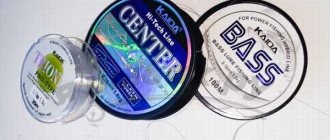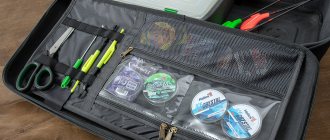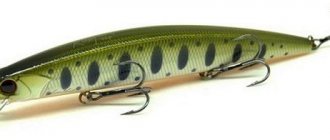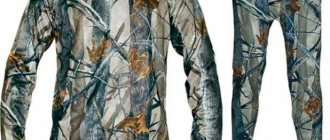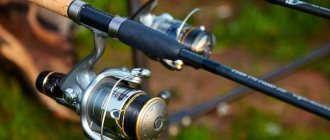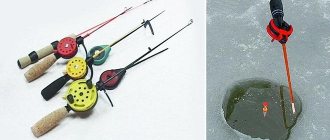Before you take up the issue of how to choose a fishing line, you need to briefly tell what a fishing line in general represents. So, fishing line is a thin artificial, mostly colorless fishing thread.
Line parameters
The cross-section or diameter of the fishing line is the most important characteristic that our fisherman focuses on. Because the diameter determines the breaking load, and even to a certain extent the softness and elasticity of the fishing line.
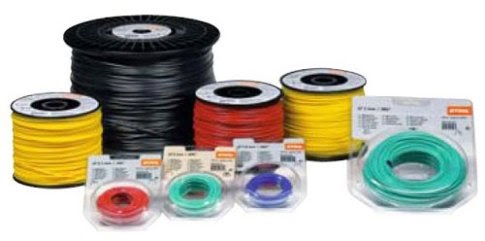
Different diameter fishing line
In addition, choosing the best diameter is a way to “revive” the bait, and therefore a tactical component. To understand this, compare the game with a jig or the work of a vertical spinner on fishing lines of different diameters. This characteristic is also reflected in the casting distance, this is especially noticeable when fishing with light tackle.
Breaking load
Most fishermen consider this characteristic to be no less significant than the previous one. Of course, most fishermen focus on the higher indicators written on the packaging. But, purchasing fishing line made abroad. We must take into account a small nuance. On high-quality sporting lines, which have the IGFA TEST certificate, the reported tensile strength is often purposefully increased. When taking into account the caught fish of a certain weight, the fishing line undergoes a tensile test and therefore the weaker its strength, the more opportunities the athlete has to take a high place.
In other cases, the difference between the declared and true tensile strength of a fishing line is often explained by the company's advertising policy. Sometimes, after testing the new fishing line for tensile strength, anglers are surprised to notice that its strength is much higher than what is shown on the sticker. In such cases, it is necessary to ensure that the actual diameter is not higher than the declared one.
Which fishing line to choose based on the technical characteristics of its breaking load, you need to pay attention to how it is preserved at the nodes. Every knot weakens the tackle. Although this also has a positive side, in the event of a snag, the fishing line does not burst along its entire length, but in a weaker place. Still, it is better to lose one leash with a hook than the entire equipment or one bait. Naturally, the strength of the fishing line at the knots must be no less than 85–95% of the real one. When tying a knot, you need to carefully monitor its exact formation, because the incorrect location of its turns tangent to each other will significantly reduce the percentage stated for this knot. For the same reason, it is not recommended to tie fishing lines with diameters that differ by more than 0.45-0.65 mm. In such situations, it is best to use a swivel.
The breaking load of the fishing line as a whole, as well as at the nodes, is reduced due to forced breaks during hooks or forced fishing for a noble trophy. In addition, when fishing in rocky areas, the last 3.5–4.5 mm of fishing line from the bait should be carefully examined and, if there is minimal suspicion of a violation of integrity, also replaced.
Elasticity
The elasticity of a fishing line describes its potential to stretch under the influence of force. This parameter is very important, and all spinning players must take it into account.
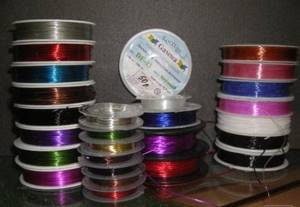
Elastic fishing line in assortment
A low-stretch line makes it possible to fish quite effectively from the bottom, because it makes it possible to “feel” the topography of the bottom of the reservoir, and, consequently, to correctly place the bait. The timeliness of recording the smoothest bites also speaks in its favor. This line is very good for catching pike perch and pike perch, as it makes it possible to hook large fish more reliably. However, a large number of failures when fishing for perch and erroneous bites when fishing for chub sometimes forces spinning anglers to “turn away” from the rigid fishing line. Practice shows that when using rods with a plastic, parabolic action, catching these fish is possible using braid.
Why a fluorocarbon leash is better than others
It is flexible, soft and difficult to see by fish; these are its main properties.
Additionally, they are easy to make yourself, and one spool of fluorocarbon line will last for many years.
Otherwise, metal leashes are more resistant to bites of predatory fish, they have a smaller diameter and higher strength. But often the fish ignores them, especially when fishing during periods with a bad bite.
A fishing line from 0.4 - 0.6 mm is used as a leash for pike; even despite such a large diameter, they are still less noticeable to a predator.
It’s impossible to say better in this case, each leash has its own purpose and everything is selected empirically and through practical tests on each body of water.
Fluorocarbon leashes are irreplaceable when catching large, cautious fish; they are different for pike; often large pike easily bite through them.
We recommend: How and whether to sharpen fishing hooks
Soft, non-elastic fishing line
As a result, the structure of the material is disrupted and, as a result, the breaking load is reduced. Naturally, with braid, which has almost zero elasticity, such changes occur much more slowly. In order to maintain the strength of the fishing line, it must be periodically untwisted.
When fishing on a river, you can simply release the line without bait into the current, which will spin it. You just need to make sure that the line running down under the influence of the current does not go down to the bottom and lift it up from time to time with a fishing rod. You can also stretch the fishing line on the shore. How often you do this is up to you, the main thing is to prevent the very tightly twisted line from drying out on the reel.
Which fluorocarbon to choose

Fluorocarbon fishing lines are quite expensive. But since it is usually used to make leashes, and one reel will last for a long time, you should not skimp on it.
Buy products from well-known brands such as Mikado, Dragon, Berkley or higher price segments. It makes no sense to look for products from little-known brands, since the manufacturing technology of such fishing lines is complex and little-known brands will most likely have low-quality fluorocarbon. Write your reviews of fluorocarbon in the comments.
Share link:
Wear resistance
This parameter must be taken into account when deciding which fishing line to prefer for spinning. The level of wear resistance is an extremely important characteristic and therefore cannot be ignored. If the fishing line is any good, it will lose its quality after three to four hours of fishing due to the influence of ultraviolet radiation or other physical factors, such as mechanical influences.
As for the ultraviolet influence, modern technologies make it possible to produce a fishing line that retains its initial characteristics (primarily elasticity and breaking load) for 650–750 hours of fishing. Although mechanical factors that damage the fishing line are unlikely to provide an opportunity to verify this in practice, especially when fishing on fast rivers. To a certain extent, the wear resistance of a fishing line also depends on its outer layer, which is Teflon or similar coatings.
A smooth and dense surface prevents such negative aspects as water absorption (hygroscopicity) and, as a result, a low degree of adhesion to the water surface. On the one hand, all this improves the sliding of the fishing line along the locking rings of the rod and, therefore, interferes less with the casting distance, and its surface is also damaged to a lesser extent.
On the other hand, a small degree of adhesion to the water surface reduces the influence of the current on the fishing line, and this makes it possible to register weak bites, and also improves the ability to control the gear.
It is necessary to pay attention to another point. If the outer coating of a monofilament line is damaged, then the line becomes an order of magnitude less reliable, and we throw it away. For most braids, even disheveled ones, the breaking load decreases less noticeably. Although in this area the coefficient of friction increases sharply, which significantly reduces the casting range, and such a fishing line does not allow a light bait to descend to the required depth (conditions sometimes do not always allow the use of heavy baits, additional sinkers and transport floats for fishing). And then we are forced to cut off the damaged piece of fishing line. Therefore, it is more profitable to buy multi-filament fishing line not in hundred-meter pieces, but by filling the reel spool directly from the reel. In some stores, they sell fishing line this way, reeling it in and pricing it by meters from large spools on which 1,500 yards of braid are wound.
How to check fluorocarbon for quality
If you have already purchased a fishing line supposedly made of fluorocarbon, but you are “tormented by vague doubts,” perform a simple test - set it on fire. A nylon fishing line burns and melts, forming a ball at the end, while a fluorocarbon fishing line goes out and does not form such an “influx” of material; the burnt tip of the fishing line crumbles in the fingers into black ash, staining the fingers.
The test is simple and quite reliable. Note! Fluorocarbon will burn on its own, it will not curl up into a pellet, and a significant amount of black ash will form at the burned end of the fishing line from the abundance of carbon. Modern fluorocarbon line may not disintegrate completely into black ash (and most likely won't). This depends on the percentage of carbon to other elements in the composition used, but carbon resin should form in appreciable quantities.
Despite the fact that more than 45 years have passed since the invention of fluorocarbon as such, Japanese manufacturers from the Kureha concern continue to be the leader and quality standard.
If you are interested in fluorocarbon leader material, be careful, do not buy these products anywhere, do not take products from unknown companies, or from well-known ones in dubious packaging.
Real high-quality fluorocarbon is a relatively expensive material. You can purchase either the leader material itself or simply a fishing line of a suitable diameter. The standard designation on fluorocarbon line labels is “Fluorocarbon” or PVDF, but there is often a clarification - 100%, reminding the angler that this is a true fluorocarbon line, and not nylon coated with fluorocarbon, designated as “fluorocarbon - coated” - the Chinese version , an attempt by the manufacturer to give nylon fishing lines the properties of fluorocarbon.
Views: 255
Similar articles:
- Fishing line for pike. Choosing monofilament and braided line for spinning When fishing for pike on a spinning rod, there cannot be one “ideal”...
- Leashes for pike: types of leashes, optimal length, determining which ones are better Pike is a desired trophy for any angler. Someone purposefully...
- Fluorocarbon leashes for pike Pike fishing is a very exciting and popular type of fishing. At…
- Fishing mugs for pike: design, equipment, methods of fishing on lakes and rivers Everything about fishing for pike with mugs. Structurally, the fishing circle…
Sinking line for fishing
When you fish with a float tackle, the line located on the water surface moves under the influence of the wind and thereby pulls the equipment along with it. This sometimes excludes the possibility of using match gear when fishing from the shore. (When fishing from a boat, you can position your back to the wind at all times.) In order to prevent the impact of air flow on the fishing line, fishermen lower it under water. But for this, a cast is made further than necessary. Next, lowering the tip of the fishing rod into the water, making several vigorous turns of the reel handle, pull up the tackle, trying to immerse the part of the fishing line located on the surface of the water between the end of the rod and the float.
Still, when casting long distances, this action does not work all the time, since the force of the water surface prevents the line from sinking. She simply slides down the surface of the water. Accordingly, the distance at which fishing is possible decreases. To increase this distance, sinking lines are created. Such fishing lines have a higher specific gravity than conventional polyamide fishing lines (1.14–1.15). Today, combined fishing lines with two or three layers with different coatings are produced. In general, modern sinking fishing lines can be divided into fishing lines with a distinct ability to submerge and conditionally sinking ones.
Fluorocarbon fishing lines have a fairly high specific gravity, and therefore a demonstrated ability to submerge.
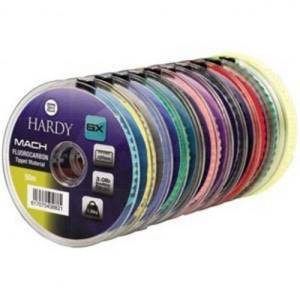
Fluorocarbon fishing lines for fishing
These fishing lines are made on the basis of fluorocarbon polymer and have the following characteristic properties:
- pronounced ability to deepen due to the high specific gravity (over 1.70);
- zero hygroscopicity, expressed in maintaining strength, relatively low elongation and stable diameter;
- sufficiently pronounced rigidity determines resistance to mechanical influences;
- the breaking ability of these lines is lower than that of polyamide ones, and this ability does not change over time;
- it is not afraid of ultraviolet radiation, therefore it practically does not age;
- the fishing line has almost no “memory”;
- it has excellent resistance to low temperatures;
- the difference between the light refractive indices of water (1.33) and fluorocarbon (1.40) is significantly less than that of polyamide fishing lines, for them it is 1.53–1.62.
This quality of fluorocarbon is advertised more often than others, since it is believed that such fishing line cannot be seen by fish.
The main disadvantage of such a seemingly super fishing line is that it has knots; you can’t do without them. First, they are very difficult for this fishing line and, having high rigidity, often come untied. Second, and this is the main thing, the breaking load at the nodes drops to 65% and below! For example, the knot strength of a fluorocarbon line recommended by Fluorocarbon Tippet Material (Scierra) for 6X (0.14 mm) fly fishing leaders is 62.5% of the stated line strength.
Advantages and disadvantages
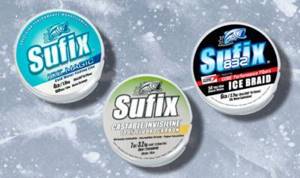
The only useful feature specifically for the cold season is that it freezes slightly less at negative air temperatures. The advantages of fluorocarbon fishing line are as follows:
- It has greater elongation than braided cord, but less than monofilament line. This property allows you to more clearly feel bites and make effective hooks.
- Not exposed to external factors such as ultraviolet radiation, temperature changes and their too high values - both positive and negative. This explains its durability.
- Does not absorb water and therefore does not lose strength due to this.
- It has no memory, so it does not begin to curl into rings even after long storage on the spool.
- In cold water it sinks three times faster than monofilament, so light baits reach the desired horizon faster.
- It has high abrasive resistance, as a result of which it is not damaged by friction against the edge of the hole.
- It is hardly noticeable in water, so it can be used when catching cautious fish.
At the same time, fluorocarbon has disadvantages, among which the main ones are the following:
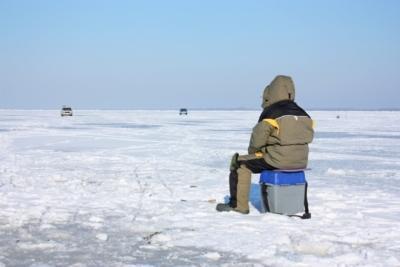
- significantly more expensive than monofilament fishing line;
- has a breaking load less than monofilament of the same diameter;
- requires the use of special units that provide a higher tensile load.



